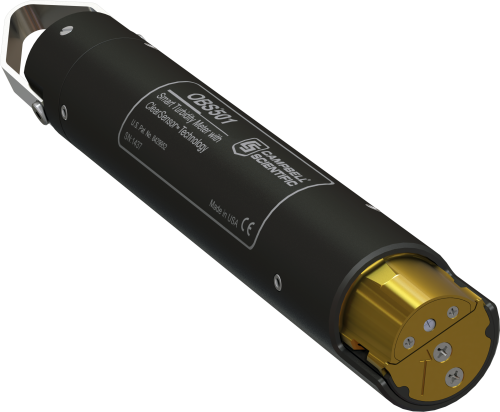This product is not available for new orders. We recommend ordering: ClariVue 10.

| Services Available | |
|---|---|
| Repair | No |
| Calibration | No |
| Free Support | Yes |
概览
The OBS501 is a submersible turbidity probe with active antifouling capabilities for better measurements in biologically active water with both high and low turbidity. It outputs an SDI-12, digitally processed signal that many of our data loggers can measure. The OBS501 is similar to the OBS500, but the OBS501 has better mechanical performance in heavy sediment/sand conditions.
优势与特点
- 后向和侧向双散射传感器用于测量浊度
- ClearSensorTM 防污损方法,用于在生物活性的水体中提供更好的测量
- 快门/擦拭机制让镜头保持清洁
- 可重复灌装的农药腔,防止污垢
- 一次性的塑料套有利于清洁
- 可选铜套管提供额外的保护(特别是在海水环境),或者一次性的塑料套管便于清洁
图像







技术说明
Design features of the OBS501 include the combination of a backscatter sensor (better at measuring higher turbidity) with a second sidescatter sensor (better at measuring lower turbidity). It has a shutter that is opened only during measurements, which reduces the time that algae or other organisms can cling to its optics.
The OBS501 is constructed to prevent sand grains or packed sediment from getting wedged between the shutter and sensor body, which inhibits the shutter’s movement. To do this, the OBS501's shutter and body were designed to eliminate parallel surfaces between moving parts wherever possible. The probe also uses a flushing action that moves the sediment down and out of the cavity behind the shutter.
To prevent biofouling and ensure better measurements, the OBS501 incorporates the ClearSensor Method (U.S. Patent No. 8,429,952. This method uses a shutter/wiper mechanism to protect and clean the optics. With the ClearSensor method, a chamber is also filled with a biocide that continuously leaches out over the optics while the probe shutter is in the closed position. ClearSensor® and OBS® are registered trademarks of Campbell Scientific.
The OBS501 can sense if the shutter’s motor is working harder than normal. If it is, the shutter moves slightly back and forth to dislodge sand grains before fully opening or closing.
Campbell Scientific offers a disposable, plastic sleeve that can make cleanup a snap, as well as a copper sleeve that can provide additional protection, especially in sea water.
产品规格
| Dual Probe | 90° sidescatter and backscatter |
| Measurement Range | 0 to 4000 NTU |
| Active and Passive Antifouling | Shutter, wiper, biocide, copper, optional removable sleeve |
| Accuracy | ±2% of reading or 0.5 NTU (whichever is greater) |
| Operating Temperature Range | 0° to 40°C |
| Storage Temperature Range | 0° to 40°C |
| Temperature Accuracy | ±0.3°C |
| Emitter Wavelength | 850 nm |
| Power Requirements | 9.6 to 18 Vdc |
| Measurement Time | < 10 s |
| Maximum Submersion Depth | 100 m (330 ft) |
| Diameter | 4.8 cm (1.88 in.) |
| Maximum Cable Length |
|
| Length | 27 cm (10.63 in.) |
| Weight | 0.59 kg (1.30 lb) |
Power Consumption |
|
| Quiescent | < 200 µA |
| Measurement | < 40 mA |
| Communication | < 40 mA |
| Active Shutter Motor | < 380 mA |
Outputs |
|
| SDI-12 | Version 1.3, 1200 bps |
| RS-232 | 9600 bps, 8 data bits, 1 stop bit, no parity, no flow control |
| Analog | 0 to 5 Vdc |
兼容性
Please note: The following shows notable compatibility information. It is not a comprehensive list of all compatible products.
数据采集器
| Product | Compatible | Note |
|---|---|---|
| 21X (retired) | ||
| CR10 (retired) | ||
| CR1000X (retired) | ||
| CR10X (retired) | ||
| CR200X (retired) | ||
| CR206X (retired) | ||
| CR211X (retired) | ||
| CR216X (retired) | ||
| CR23X (retired) | ||
| CR295X (retired) | ||
| CR300 (retired) | ||
| CR3000 (retired) | ||
| CR310 | ||
| CR500 (retired) | ||
| CR5000 (retired) | ||
| CR510 (retired) | ||
| CR6 | ||
| CR800 (retired) | ||
| CR850 (retired) | ||
| CR9000 (retired) |
相关技术文档
技术论文
- OBS and Turbidity Sensors Basics (2Q-P)
- OBS: Comparison of Suspended Solids Concentration (SSC) and Turbidity
- Innovative Sensor Design for Prevention of Bio-fouling
- OBS: Effects of Bubbles
- OBS: Effects of Light Absorption and Scattering in Water Samples on Measurements
- OBS: Effects of Suspended Solids Concentration (SSC)
- OBS Measurements: Effects of Sediment Color
- OBS Measurements: Effects of Sediment Size
- OBS Measurements: Effects of Water Color
- OBS Sensors: Turbidity Calibration
- OBS Sensors: Sediment Calibration
- OBS Sensors: Light Sources and Photodetectors
- OBS Sensor: Effects of Fouling on the Lens
常见问题解答
OBS501: 1
-
What are the differences between the different turbidity units used, such as NTU, FBU, FTU, and FNU?
It used to be that NTUs were the unit for all turbidity sensors. In 2007, an ASTM committee formed and established different units for each category of turbidity sensor technology, and there are many. Backscatter sensors such as the OBS-3+ and the OBS501 have units of FBU (Formazin Backscatter Units), whereas ISO 7027 side-scatter sensors have units of FNU (Formazin Nephelometric Units). The side-scatter OBS501 and the ClariVue™ sensors are part of this category. While sensors of different technical designs can be calibrated and measure Formazin the same, they will not make the same measurement in natural waters where size, shape, color, reflectivity, etc., of the particles vary. The ClariVue™ sensor measurements will not match the OBS-3+ measurements in natural waters.
